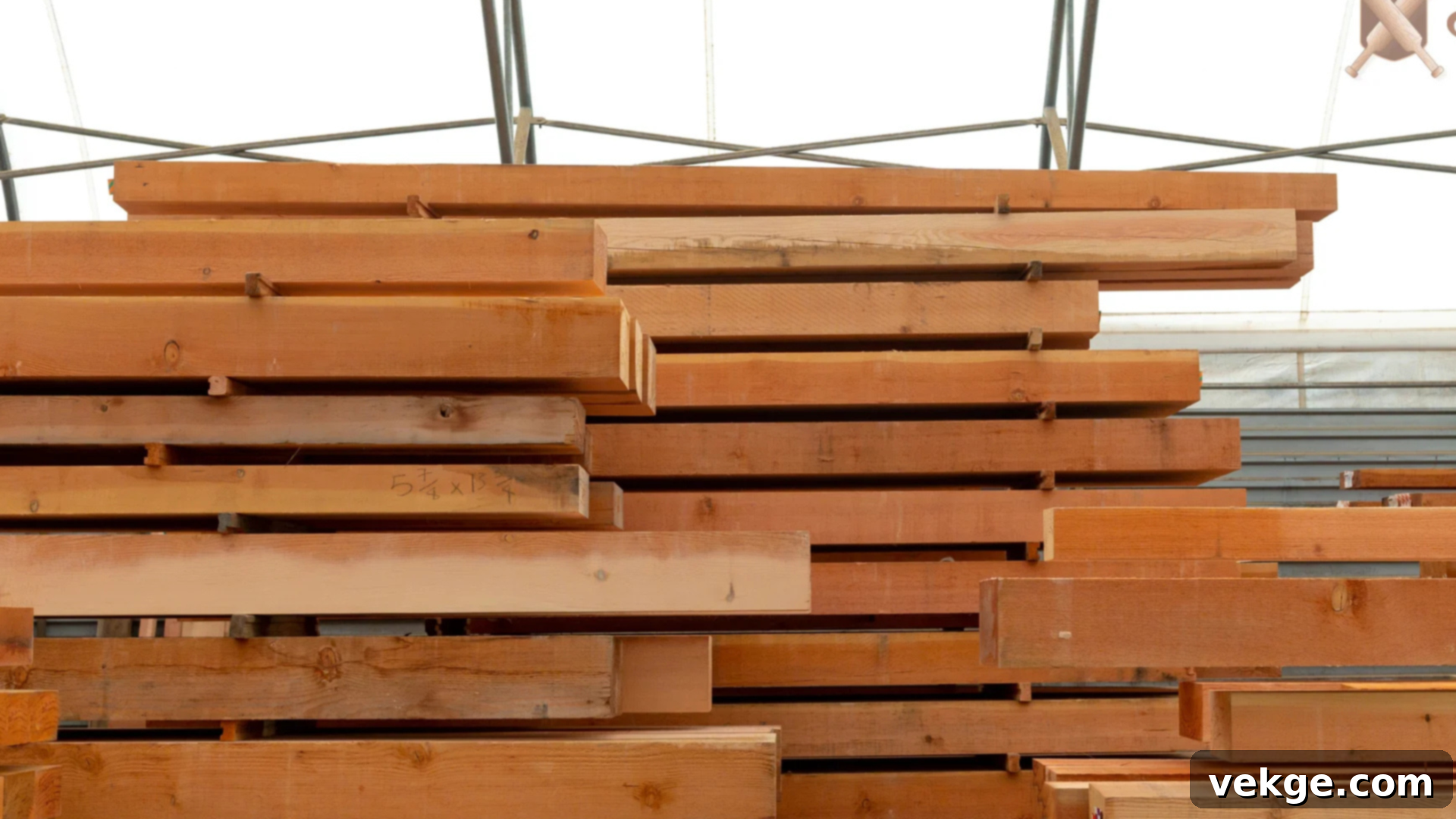The Ultimate Guide to Kiln-Dried Wood: Benefits, Uses, and How to Choose
If you’ve ever invested time and effort into a woodworking project, only to see the wood warp, crack, or twist just a few weeks later, you understand the immense frustration. The truth is, not all lumber is prepared for immediate use straight from the sawmill. This often leads to unstable results, wasted materials, and disappointment.
That’s where kiln-dried wood comes in. This comprehensive guide is designed to demystify kiln-dried lumber, explaining why it’s a superior choice for a vast array of projects and how it can save you significant headaches down the line. We’ll explore its meticulous creation process, compare it with other wood types, highlight its best applications, and equip you with the knowledge to make informed purchasing decisions.
By the end of this guide, you’ll feel confident in selecting the right kiln-dried wood for your specific needs, ensuring greater stability, longevity, and success for all your woodworking and construction endeavors. Say goodbye to unpredictable wood and hello to reliable craftsmanship!
Understanding Kiln-Dried Wood
To truly appreciate the value of kiln-dried wood, it’s essential to understand what it is and how it stands apart from other forms of lumber. This section will break down the fundamental definition and highlight its key differences and advantages over air-dried and green alternatives in terms of quality and practical use.
Basic Definition of Kiln-Dried Wood
Kiln-dried wood refers to lumber that has undergone a highly controlled drying process within a specialized chamber called a kiln. This process utilizes precisely regulated heat, humidity, and airflow to systematically reduce the internal moisture content of the wood to a specific, uniform level. Unlike natural drying methods, kiln drying achieves a significantly lower and more consistent moisture level throughout the entire piece of wood.
This meticulous reduction of moisture is crucial. By removing excess water efficiently and evenly, the wood becomes inherently more stable. This enhanced stability prevents common issues such as swelling, shrinkage, twisting, cupping, or cracking, which are direct results of moisture fluctuations. Furthermore, the heat involved in kiln drying effectively sterilizes the wood, eliminating pests, fungi, and mold spores. Consequently, kiln-dried wood is celebrated for its improved reliability, workability, and longevity, making it the material of choice for demanding applications like fine furniture, high-quality flooring, and intricate cabinetry.
Kiln Drying vs. Air Drying vs. Green Lumber
The primary distinction among these three forms of lumber lies in their preparation methods, particularly how their moisture content is managed. Each approach profoundly impacts the wood’s stability, workability, and long-term durability. Understanding these differences is key to choosing the right material for your project.
Green Lumber is simply wood that has been freshly cut from the tree and has undergone no drying process whatsoever. Its moisture content is very high, often exceeding 30%. While it’s the most readily available and least expensive option, its instability makes it unsuitable for most interior or precision applications. It’s highly prone to significant shrinkage, warping, checking, and is susceptible to decay and insect infestation.
Air-Dried Lumber relies on natural atmospheric conditions to reduce its moisture content. Boards are stacked with spacers (stickers) between them, allowing air to circulate freely. This method is cost-effective as it requires no energy input, but it’s a slow process, often taking months or even years depending on the wood species, thickness, and local climate. Crucially, air drying can only reduce the moisture content to the ambient Equilibrium Moisture Content (EMC) of its environment, which is typically around 12-20% in most outdoor settings. While more stable than green lumber, it may still be too wet for interior applications where a lower moisture content (6-8%) is required to prevent movement.
Kiln-Dried Lumber, as discussed, is subjected to a controlled environment of heat, humidity, and airflow. This accelerates the drying process significantly, reducing the drying time from months to days or weeks. More importantly, it allows for precise control over the final moisture content, typically bringing it down to 6-8% for interior uses, which matches the EMC of most indoor environments. This precise control results in highly stable, predictable lumber that is less prone to movement, dimensionally consistent, and free from pests and mold. While it carries a higher initial cost due to the energy and equipment involved, the superior quality and reduced waste often make it the most economical choice in the long run for critical projects.
|
Type |
Method |
Pros |
Cons |
Common Uses |
|
Green Lumber |
Fresh cut, no drying |
Readily available, lowest cost, easy to saw |
Prone to severe warping, checking, decay, pests; significant shrinkage |
Rough construction, temporary structures, outdoor applications where movement is acceptable (e.g., fence posts) |
|
Air-Dried Lumber |
Open-air exposure, natural airflow |
Lower cost than kiln-dried, no energy required, less stress on wood fibers |
Takes months to years, less moisture control (limited by ambient EMC), potential for insect damage/stains, inconsistent drying |
Outdoor furniture, fencing, decking, sheds, rough framing where lower stability is tolerated |
|
Kiln-Dried Lumber |
Controlled heat, humidity, and airflow in a chamber |
Highly stable, faster drying, precise moisture control, pest and mold-resistant, reduced defects, excellent workability |
Higher cost, requires energy, can induce internal stress if improperly dried |
Fine furniture, cabinetry, interior flooring, musical instruments, millwork, structural components requiring high stability |
How the Kiln Drying Process Works
The effectiveness of kiln-dried wood stems directly from its meticulously controlled drying process. This section delves into the mechanics of how lumber is dried in a controlled setting to achieve optimal moisture levels, exploring the types of kilns used, the critical steps involved, and the overarching importance of moisture balance for producing usable and stable wood.
What is a Wood Kiln?
A wood kiln is essentially an insulated, heated chamber specifically designed to dry lumber faster and more uniformly than natural methods. These sophisticated systems meticulously control three key environmental factors: temperature, relative humidity, and airflow. By manipulating these variables, operators can extract moisture from wood fibers in a precise and controlled manner, minimizing internal stresses and potential defects.
Common types of wood kilns include:
- Conventional Kilns: These are the most widespread type. They typically use steam or hot water coils to heat the air within the chamber, while powerful fans circulate the heated air through stacks of lumber. Humidity is managed by introducing steam or venting moist air. Conventional kilns are versatile and effective for a wide range of wood species and thicknesses.
- Dehumidification Kilns: These kilns operate on a closed-loop system, using a refrigeration cycle to condense moisture from the air, much like a household dehumidifier. The heat generated by the refrigeration process is recycled back into the kiln, making them highly energy-efficient, especially for lower temperatures. They are excellent for gentler drying cycles and smaller operations.
- Vacuum Kilns: These advanced kilns operate at significantly reduced atmospheric pressure. By lowering the pressure, the boiling point of water is drastically reduced, allowing wood to be dried at much lower temperatures. This gentler process is ideal for preserving the color and integrity of sensitive or thicker wood pieces, minimizing defects like checking and warping. Vacuum kilns are faster but also more expensive to operate.
Kiln Drying Process Breakdown: Stacking and Preparation
Even before the wood enters the kiln, proper stacking and preparation are paramount to a successful drying cycle. A poorly stacked load can lead to uneven drying, defects, and wasted lumber. Here’s a typical breakdown of the preparation steps:
Step 1: Lay Down Long Spacers (Foundation)
Start by placing sturdy, long spacers (e.g., 2.5″x4′ pieces of wood) directly on the kiln floor. These foundation spacers serve two critical purposes: they lift the entire stack off the floor, allowing essential airflow underneath, and they provide a level, stable base. Using a straightedge to ensure all spacers align on the same plane is crucial, as any unevenness here will be magnified throughout the stack, leading to bowing or twisting in the lower layers.
Step 2: Place Thickest Boards as the Bottom Layer
Once the foundation spacers are set, position your thickest and heaviest boards (such as 2.5″ slabs) as the very first layer of lumber. This creates a robust and stable foundation for the entire stack. Thicker boards are naturally more resistant to warping under the immense weight of the layers above, ensuring the stability of the overall structure during the drying process.
Step 3: Utilize 1″x1″ Stickers for Airflow
Between each subsequent layer of lumber, carefully place 1″x1″ stickers. These stickers are vital for creating consistent air channels throughout the stack, allowing the heated and dehumidified air to circulate evenly around every board. It’s absolutely critical that these stickers are aligned directly above the base spacers. This perfect vertical alignment ensures that the weight of the upper layers is distributed directly down through the stickers and foundation spacers, preventing the boards from bowing, sagging, or developing pressure marks.
Step 4: Add Horizontal Spacers for Machinery Access
For very large or heavy stacks, strategically add horizontal spacers (often wider and thicker than regular stickers) between major sections of the stack. These larger gaps allow forklifts or other machinery to safely lift and move portions of the stack later without the need for manual unstacking. This significantly improves efficiency and reduces the risk of injury or damage when handling the dried lumber.
Step 5: Group Boards of Similar Thickness and Orient Pith Correctly
To ensure uniform drying and minimize defects, keep boards of similar thickness grouped together within the stack. Thicker boards require longer drying times, and mixing them with thinner ones can lead to over-drying of the latter or under-drying of the former. Additionally, align the log’s pith (the very center of the tree trunk) towards the bottom of the stack if present in your boards. This orientation helps reduce the likelihood of splitting as the wood dries and shrinks, as the pith area is particularly prone to checking.
Step 6: Protect the Stack from Direct Sunlight (Pre-Kiln or During Air Drying)
While primarily a concern for air drying or pre-drying before the kiln, protecting lumber stacks from direct sun exposure with tarps or house wrap is a crucial step. Rapid, uncontrolled drying of the surface due to sun can lead to “case hardening” and severe surface cracks (checks) before the internal moisture has a chance to dissipate. Slowing down the initial drying phase promotes a more even moisture gradient throughout the wood, resulting in higher quality lumber with fewer defects.
Step 7: Apply Weight to the Top of the Stack
Finally, place heavy items such as concrete blocks, rocks, or specialized weights on top of the uppermost layer of the lumber stack. This compression helps to prevent the boards from bowing, twisting, or lifting during the drying process, ensuring they remain flat and dimensionally stable. The consistent downward pressure counteracts the internal stresses that develop as wood shrinks, contributing significantly to flat, usable lumber.
Want to see the whole process in action? Watch this step-by-step video walkthrough for clear, practical guidance on how to properly stack lumber for drying, a fundamental step in the kiln-drying process.
Moisture Content & EMC Explained
Understanding moisture content (MC) and Equilibrium Moisture Content (EMC) is fundamental to working with wood, especially kiln-dried lumber. These concepts dictate how wood behaves and its suitability for various environments, directly impacting the longevity and stability of your projects.
Moisture Content (MC) refers to the amount of water present in a piece of wood, expressed as a percentage of the wood’s oven-dry weight. Freshly cut, or “green,” wood can have an MC of 30% to over 200%, depending on the species. For most indoor applications, kiln-dried wood is typically brought down to an MC of 6-8%, which is considered optimal for stability in climate-controlled environments.
Equilibrium Moisture Content (EMC) is the critical point where the moisture in the wood has balanced with the relative humidity and temperature of its surrounding environment. Wood is a hygroscopic material, meaning it constantly exchanges moisture with the air around it. If the wood’s MC is higher than the ambient EMC, it will release moisture; if its MC is lower, it will absorb moisture. When wood reaches EMC, it neither gains nor loses moisture, becoming dimensionally stable for that specific environment.
Kiln drying aims to bring the wood’s MC down to a level that matches the EMC of its intended end-use environment. For instance, wood destined for indoor furniture in a heated home needs a much lower MC (e.g., 6-8%) than wood for an outdoor fence (which might be stable at 12-15% MC). If wood is too wet or too dry for its environment, it will inevitably try to reach EMC, leading to undesirable changes: it may shrink, swell, cup, bow, or crack. Maintaining an MC that is in equilibrium with the project’s environment significantly reduces these risks, ensuring that your furniture joints remain tight, your floors stay flat, and your creations endure for years without movement. This makes understanding and managing EMC absolutely critical for product longevity and structural integrity.
Common Uses for Kiln-Dried Wood
Kiln-dried wood is the preferred choice for a multitude of practical applications due to its significantly reduced and stabilized moisture content. This characteristic fundamentally improves its durability, performance, and overall suitability across a broad spectrum of residential, commercial, and industrial needs. Its reliability makes it indispensable where precision and longevity are paramount.
Furniture & Cabinetry
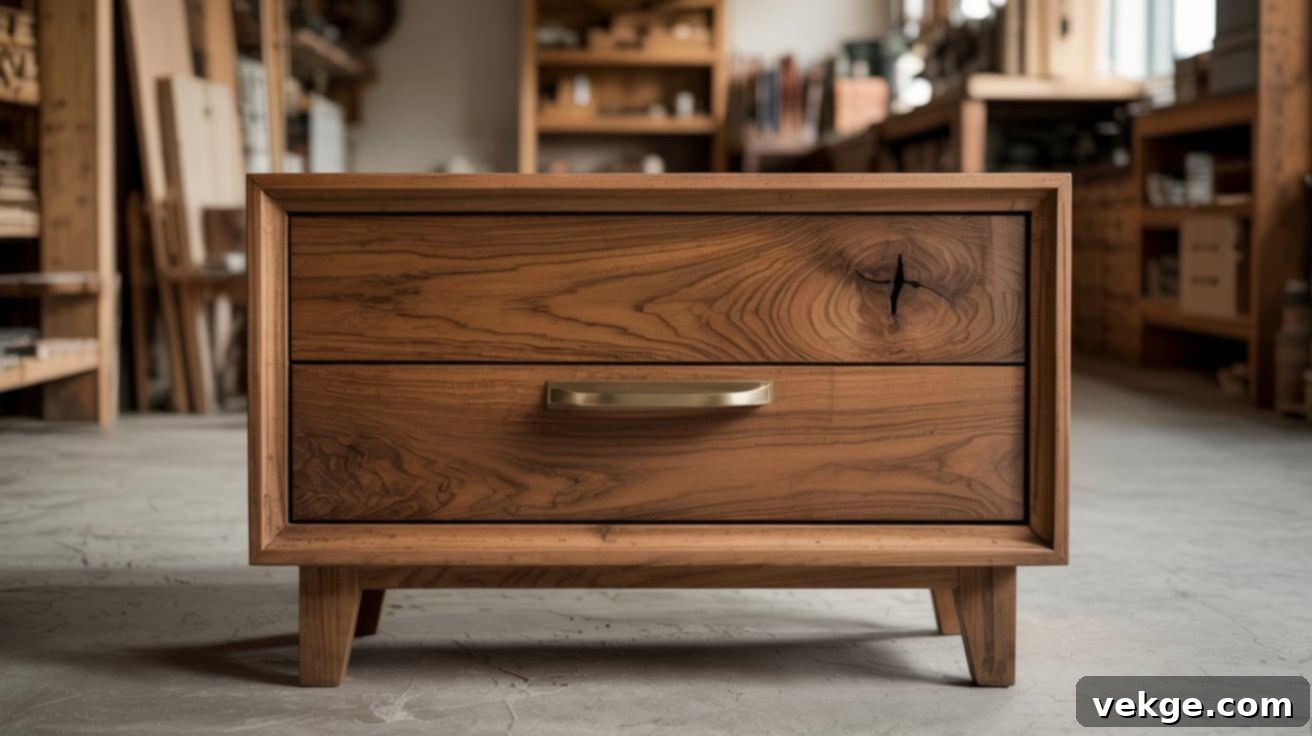
Kiln-dried wood is the gold standard for crafting high-quality tables, chairs, cabinets, shelving units, and other fine furniture pieces. Its unparalleled stability and minimal risk of distortion are paramount in these applications. The low and consistent moisture content ensures that the wood maintains its intended shape and structural integrity, especially at critical joinery points. This consistency makes assembly far more reliable, as mortise and tenon joints, dovetails, and glued panels will fit precisely and remain strong without gapping or separating over time.
Since the lumber remains dimensionally consistent, it’s easier to machine, cut, and fasten during construction, leading to tighter tolerances and a superior finished product. This reliability is not just about initial appearance; it’s essential for furniture designed to endure regular use and varying indoor climates without warping, checking, or developing unsightly cracks. For furniture makers, using kiln-dried wood translates to fewer callbacks, higher customer satisfaction, and a reputation for craftsmanship that lasts.
Flooring & Paneling
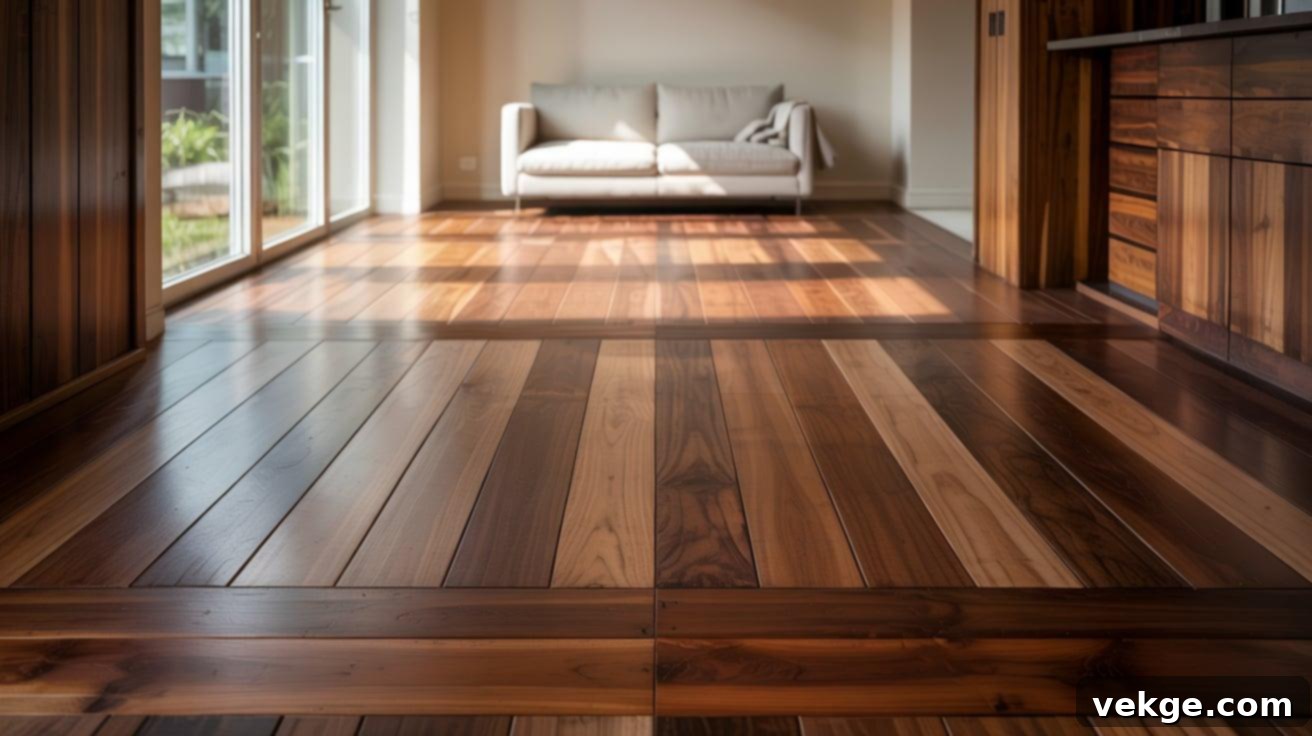
For indoor floors and wall panels, where even minor shifts in moisture can lead to unsightly and costly problems, kiln-dried lumber is indispensable. Its precisely controlled moisture content minimizes the chances of issues like buckling, cupping, gapping between boards, or surface defects once installed. Hardwood flooring, whether solid or engineered, relies heavily on this stability to maintain its aesthetic appeal and structural integrity over decades.
The consistent shape and reduced moisture levels of kiln-dried wood make it perfectly suited for precision-cut flooring systems, tongue-and-groove boards, and elaborate decorative paneling. This consistency ensures tight fits during installation and reduces the likelihood of adhesive failures or fastener pull-out. Furthermore, in rooms where climate control is common (heating and air conditioning), kiln-dried wood maintains its form, significantly enhancing long-term structural performance and preserving the finished appearance of the space. It prevents the unsightly gaps in winter and the buckling in humid summers that plague projects using inadequately dried wood.
Outdoor Projects

While often associated with indoor applications, kiln-dried wood can be an excellent choice for outdoor projects, provided it is properly sealed and maintained. For structures like fences, pergolas, gazebos, garden furniture, and exterior trim work, a smooth, dry, and stable material is often preferred for ease of construction and a superior finish. Starting with kiln-dried wood means less initial movement and shrinkage compared to green or even air-dried lumber, allowing for tighter joints and more precise construction from the outset.
However, it is absolutely critical that kiln-dried wood used outdoors is thoroughly sealed with appropriate outdoor finishes, stains, or paints. This protective barrier is essential to prevent the wood from reabsorbing moisture from the environment, which would negate the benefits of the kiln-drying process and lead to swelling, checking, and decay. When adequately protected, kiln-dried wood offers a more stable and aesthetically pleasing option for durable outdoor constructions, providing a better foundation for long-term performance.
Firewood & BBQ Applications
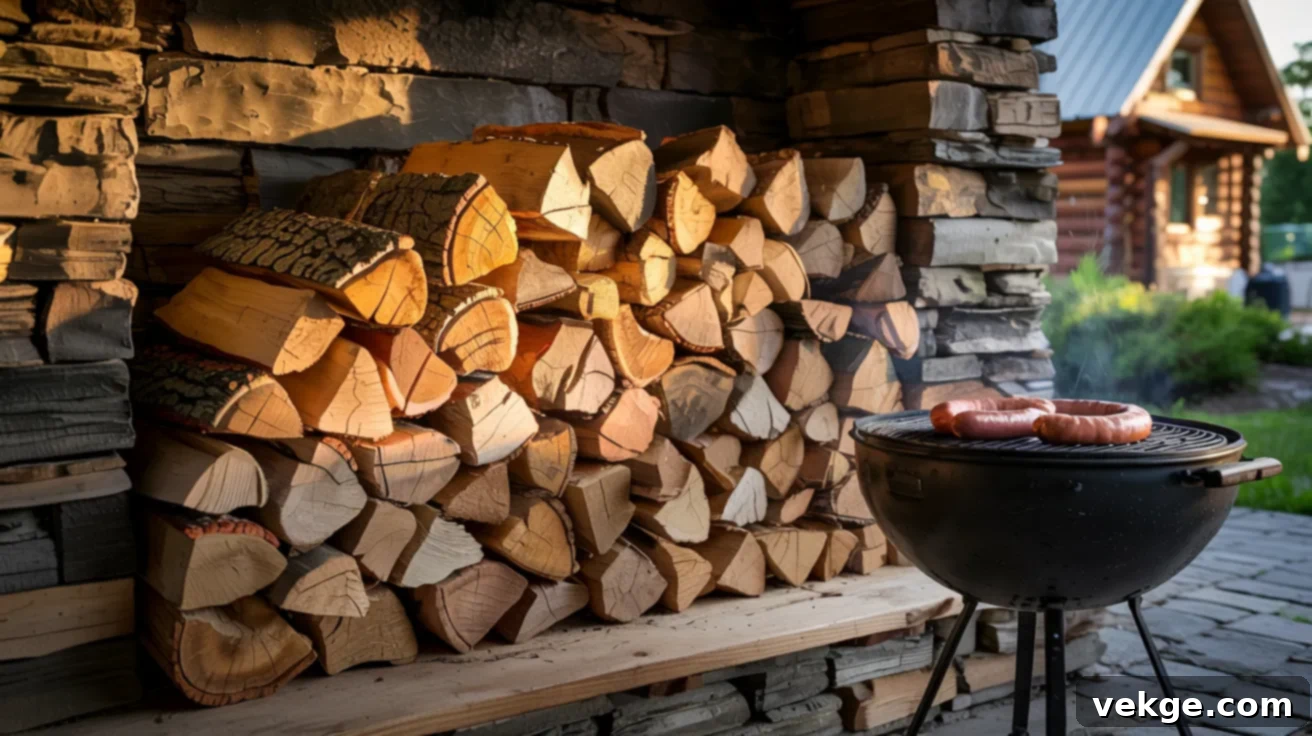
Beyond construction and carpentry, kiln-dried wood offers significant advantages when used as firewood or for cooking applications. Kiln-dried firewood burns dramatically cleaner and more efficiently than wood that hasn’t been properly dried, commonly known as “green” wood or even poorly air-dried wood. The significantly lower moisture content (typically below 20%) allows it to ignite much faster, produce substantially more heat (higher BTU output), and generate far less smoke and creosote buildup in chimneys.
For cooking or grilling, especially in wood-fired ovens, smokers, or fire pits, kiln-dried wood is highly preferred. It generates fewer sparks, burns more evenly and predictably, and produces a cleaner smoke that imparts a better flavor to food, free from the acrid notes of wet wood. The intense heat of the kiln-drying process also serves a crucial purpose: it effectively eliminates pests, insects, and mold spores from the wood. This makes it safer for indoor storage before use, without the worry of introducing unwanted guests into your home or commercial kitchen. It’s a premium choice for both cozy firesides and gourmet culinary experiences.
How to Identify Kiln-Dried Wood
Knowing how to confidently identify kiln-dried wood is an invaluable skill for any woodworker, builder, or homeowner, ensuring you select the appropriate material for your project. This section will outline the key visual signs, the essential tools, and the labeling methods used by reputable suppliers and retailers to help you verify the wood’s drying status.
Visual Signs of Kiln-Dried Wood
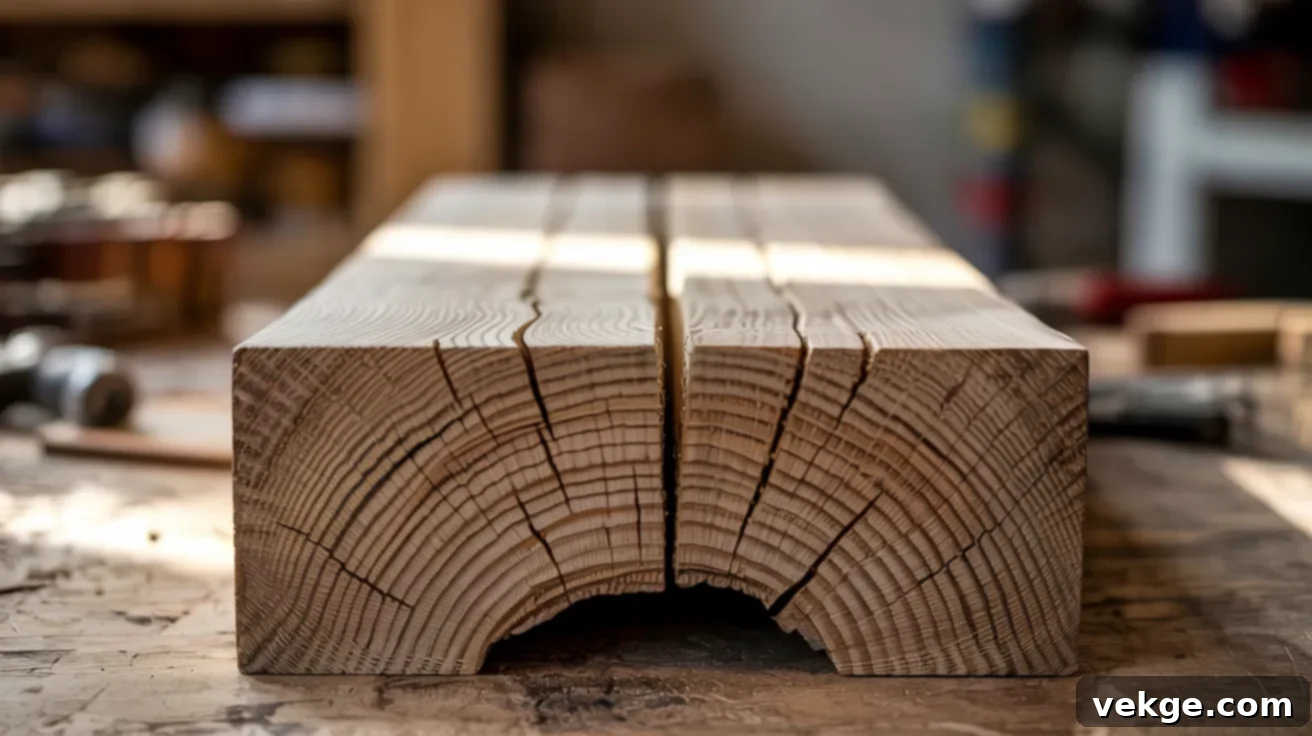
While visual inspection is not foolproof, several characteristics can suggest that wood has been kiln-dried. Kiln-dried wood typically exhibits a clean, brighter, and more uniform appearance compared to its green or air-dried counterparts. The color throughout the board tends to be more consistent, with less pronounced discoloration from sap stains or fungi, which are common in slower drying methods. The ends of kiln-dried boards may often appear slightly darker due to the more rapid moisture escape from end grain, or they might be sealed with wax or a special coating to prevent excessive end-checking during drying.
Visible cracks (checks) are usually minimal and, if present, tend to be limited to the surface. Severe end checks or deep splits are less common in properly kiln-dried material. The grain of the wood often appears tighter and more consistent, a result of the controlled and even shrinkage. You should also notice a distinct lack of active insect damage (boreholes, sawdust trails) or visible mold growth, as the heat of the kiln effectively sterilizes the wood. However, these are indicators, not guarantees; always combine visual inspection with other verification methods when possible.
Using a Moisture Meter

A moisture meter is undoubtedly one of the most reliable and essential tools for verifying if lumber has been properly kiln-dried and, more importantly, if it has maintained its low moisture content. For interior applications, properly dried hardwoods typically show moisture content readings between 6% and 8%, though this can vary slightly based on the regional climate and the specific end-use environment. Softwoods often target slightly higher ranges, around 8-12% MC.
There are two main types of moisture meters: pin-type meters, which use two small probes inserted into the wood, and pinless meters, which scan the wood’s surface without leaving marks. Pinless meters are generally preferred for finished surfaces or when you want to avoid cosmetic damage. Regularly checking the moisture content of lumber before purchase and immediately prior to starting a project is critical. This helps prevent frustrating and costly issues like warping, cupping, or joint failure that arise from using wood with excessive moisture. For bulk orders, it’s highly recommended to test multiple boards from different parts of the stack to ensure consistent dryness throughout the entire lot.
Labeling at Lumber Yards

Reputable lumber suppliers and retailers typically provide clear labeling for their kiln-dried stock. You’ll often find abbreviations such as “KD” (Kiln Dried) or “KDHT” (Kiln Dried, Heat Treated) stamped directly on the ends of boards, printed on plastic wrap covering bundles, or indicated on shelf tags and inventory lists. These labels are meant to provide confidence in the drying process.
Beyond these common acronyms, some labels might also include specific moisture content ranges (e.g., “KD 6-8%”) or indicate compliance with industry standards, such as ISPM 15 for international shipping (which requires heat treatment to eliminate pests). It’s always a good practice to ask the staff at the lumber yard to confirm the drying process used and to inquire about the specific moisture specifications. Be aware, however, that even if wood was initially kiln-dried, it can reabsorb moisture if it’s not stored correctly in a climate-controlled environment at the yard. Therefore, while labeling is a good starting point, it should always be verified with the actual condition of the wood, ideally using your own moisture meter, especially if the storage conditions appear suboptimal.
Buying Guide for Kiln-Dried Wood
Selecting the right kiln-dried wood goes beyond simply checking for a “KD” label. Making an informed purchase requires asking the right questions, carefully evaluating the wood’s grade and moisture levels, and recognizing potential signs of improper drying or reabsorbed moisture. This guide will help you navigate the lumberyard with confidence.
What to Ask Your Supplier
A reputable wood supplier should be transparent and willing to provide detailed information about their lumber. Here are key questions to ask:
- What is the average moisture content (MC) range of this batch? Request a specific percentage, typically 6-8% for indoor projects.
- What drying method was used? (Conventional kiln, dehumidification kiln, vacuum kiln). This can indicate the quality and consistency of the drying.
- How was the wood stored after processing? Proper storage in a climate-controlled environment is crucial to prevent reabsorption of moisture.
- Was the wood dried to suit indoor or outdoor use? The target MC differs significantly for these applications.
- Does it meet local or industry standards for specific applications (e.g., furniture, flooring, structural)? This confirms its suitability for your project’s demands.
- Can I use a moisture meter to check the wood before purchase? A good supplier will allow this and may even offer to check it for you.
- What species is this wood, and where was it sourced? Origin and species can affect price, grain, and density.
Reputable suppliers will offer clear answers, may provide documentation (such as a kiln certificate), and are often happy to use a moisture meter on the spot to confirm dryness. Be wary of suppliers who are vague or unwilling to provide specific details.
Choosing the Right Grade & Moisture Level
Selecting the correct grade and moisture level is paramount to the success of your project:
- Wood Grade: Lumber grades are primarily based on the number and size of defects (knots, checks, mineral streaks, sapwood, etc.) and the amount of clear, usable material a board yields. Higher grades, such as FAS (First and Seconds) or Select & Better for hardwoods, have fewer defects and are ideal for fine furniture, cabinetry, or visible components where aesthetics are critical. Lower grades (e.g., Common 1, Common 2) are more economical and suitable for painted projects, structural elements, or applications where character marks are desired. Always select a grade that matches your project’s visual and structural requirements.
- Moisture Level:
- For indoor use (furniture, cabinetry, flooring): The moisture content should typically fall between 6% and 8%. This range aligns with the Equilibrium Moisture Content of most heated and air-conditioned interior environments, minimizing movement.
- For outdoor use (fencing, pergolas, decking): Slightly higher moisture levels, typically 10-15%, may be acceptable, especially if the wood will be sealed, treated, or exposed to the elements. However, even for outdoor projects, starting with stable, kiln-dried wood can reduce initial movement and make construction easier.
Always match the moisture level of the wood to the environment where it will be installed or used to ensure maximum stability and longevity.
Be Cautious: Kiln-Dried Wood Can Regain Moisture
It’s a critical misconception to assume that wood labeled “kiln-dried” will always arrive perfectly dry. While it was indeed processed in a kiln, wood is hygroscopic and will readily absorb moisture again if exposed to damp or humid conditions during transport, storage at the lumberyard, or even in your own workshop. This reabsorption can completely negate the benefits of kiln drying.
Therefore, it is absolutely essential to always use a reliable moisture meter on every board you intend to use, even if it’s explicitly labeled KD. Watch carefully for visual signs of reabsorption, such as swelling, slight cupping, distortion, or the reappearance of surface mold, all of which could indicate the wood has picked up unwanted moisture. If possible, once you bring the wood into your workshop or the final installation environment, allow it to “acclimatize” for several days or even weeks. This period allows the wood’s moisture content to slowly equalize with its new surroundings, significantly reducing the risk of performance issues like warping, splitting, or joint failure after your project is completed. Store it properly, stickered, and away from direct sunlight or damp areas during this critical acclimatization phase.
Sustainability & Efficiency in Kiln Drying
The process of kiln drying, while highly effective, also carries implications for energy consumption and resource management. Modern advancements and best practices are continuously improving the environmental and operational efficiency of lumber drying. Understanding these factors highlights the responsible aspects of using kiln-dried wood:
- Heat Recovery Systems: Many contemporary kilns are equipped with sophisticated heat recovery systems. These technologies capture and reuse waste heat generated during the drying cycle, significantly reducing the overall energy required and lowering operational costs and carbon footprint.
- Solar-Powered Kilns: In regions with abundant sunlight, passive and active solar-powered kilns offer a low-energy, environmentally friendly alternative. While often slower than conventional kilns, they harness renewable energy, making them highly sustainable for certain applications and climates.
- Efficient Scheduling and Loading: Optimizing kiln schedules to run full loads and employing species-specific drying programs minimizes unnecessary heating cycles and energy waste. Proper stacking techniques, as discussed, also contribute to uniform and efficient drying, preventing the need for re-drying or rejection of lumber.
- Sustainable Timber Sourcing: The efficiency of kiln drying is enhanced when integrated with sustainable forestry practices. Using timber harvested from sustainably managed forests ensures a long-term supply of raw material and supports forest conservation, offsetting the energy used in drying.
- Advanced Insulation and Kiln Design: Modern kiln designs incorporate superior insulation materials and airtight construction. This minimizes heat loss to the surrounding environment, ensuring that energy is concentrated on drying the wood, thereby improving efficiency and reducing energy consumption.
- Reduced Waste: By producing more stable and defect-free lumber, kiln drying indirectly contributes to sustainability by reducing material waste during manufacturing and ensuring a longer lifespan for finished wood products, thus decreasing the demand for new timber resources over time.
Conclusion
You’ve now navigated through the essential aspects of kiln-dried wood, gaining a comprehensive understanding of its unique properties and the benefits it brings to any project. Gone are the days of uncertainty and frustration caused by unpredictable lumber. You now know that choosing kiln-dried wood means opting for a material that is significantly more stable, easier to work with, and fundamentally resistant to the moisture-related issues that plague less prepared lumber.
We’ve covered the meticulous process of how it’s made, how it stands superior to air-dried and green alternatives, and its versatility across various applications, from fine furniture to efficient firewood. More importantly, you’re now equipped with the practical knowledge to ask the right questions of your supplier, identify quality kiln-dried lumber using visual cues and moisture meters, and understand the critical importance of acclimatization before you begin your project.
Remember, the success and longevity of your woodworking and construction endeavors hinge on the stability of your materials. By making informed choices and verifying the condition of your wood, you’re setting yourself up for professional-grade results and lasting satisfaction. Take this knowledge with you, and build with confidence!
Frequently Asked Questions About Kiln-Dried Wood
Q1: Is kiln-dried wood better than air-dried wood?
For most interior applications, yes, kiln-dried wood is generally superior. While air-dried wood is less expensive and can be suitable for some outdoor projects, kiln drying offers precise control over the final moisture content, typically bringing it down to 6-8%, which matches indoor environments. This results in much greater stability, less shrinkage, and fewer defects, making it ideal for furniture, flooring, and cabinetry where dimensional stability is critical. Air-dried wood often retains a higher moisture content (12-20%) and can be less consistent.
Q2: How long does kiln drying take?
The duration of the kiln-drying process varies significantly based on several factors, including the wood species, thickness of the lumber, the initial moisture content, and the type of kiln used. Softwoods generally dry faster than hardwoods. Thin boards (e.g., 1-inch thick) might take a few days to a week, while thicker slabs (e.g., 3-inch or more) of dense hardwoods could take several weeks. Overall, kiln drying is dramatically faster than air drying, which can take months to years.
Q3: Does kiln drying remove all moisture from wood?
No, kiln drying does not remove all moisture from wood, nor should it. Wood needs a certain amount of moisture to remain stable and workable. The goal of kiln drying is to reduce the moisture content to an “equilibrium” level (EMC) that matches the environment where the wood will be used (e.g., 6-8% for indoor furniture). Removing all moisture (making it “oven-dry”) would make the wood extremely brittle and prone to cracking when it eventually reabsorbs moisture from the air.
Q4: Can kiln-dried wood be used outdoors?
Yes, kiln-dried wood can be used for outdoor projects, but it requires proper protection. Because its moisture content is very low, it will readily absorb moisture from the humid outdoor environment if left untreated. To prevent swelling, checking, and decay, kiln-dried wood used outdoors must be thoroughly sealed, painted, or stained with a high-quality exterior finish. For many outdoor applications, pressure-treated or naturally rot-resistant species (like cedar or redwood) might be more practical or cost-effective, but kiln-dried wood offers excellent initial stability if properly maintained.
Q5: How should I store kiln-dried wood before use?
To maintain its stability, kiln-dried wood should be stored in a dry, climate-controlled environment that mimics its eventual end-use location. Stack the lumber neatly on level stickers (small strips of wood) placed every 12-18 inches, ensuring good air circulation around all surfaces. Keep it off the floor and away from direct sunlight, heating vents, or exterior walls, which can cause localized moisture fluctuations. Allowing the wood to “acclimatize” in your workshop for several days or weeks before milling is a best practice to ensure its moisture content is truly stable for your specific environment.
